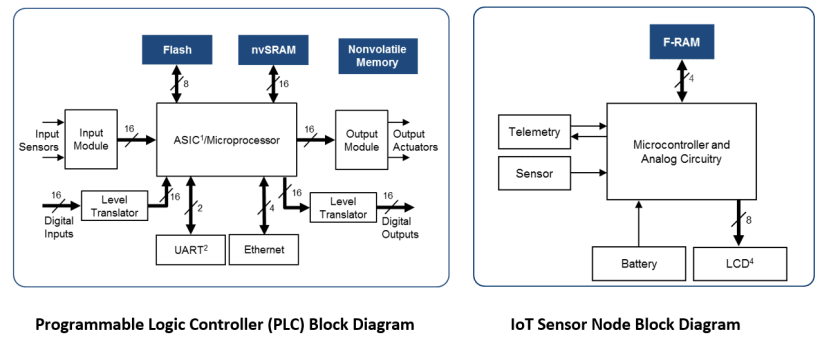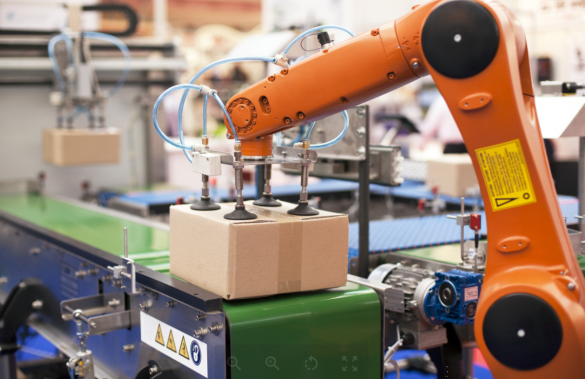Cypress Nonvolatile RAM for the Industrial IoT
With the advent of Industrial IoT, factories are growing smarter and more connected. Machines in smart factories can detect a failure, even before it occurs, using real-time data from connected sensor nodes, and inform the control system to take corrective action to fix the failure. The accumulated data can then be used to refine the predictive analytics and enable better preventive maintenance of the machines. These advancements are targeted to reduce industrial downtime, which is currently both difficult to predict and extremely expensive – for example, downtime can cost up to $1.3M per hour in an automotive manufacturing facility.
The bedrock for Industrial IoT, one that enables everything from real-time sensing to predictive maintenance, is data. Therefore, having secure, reliable, data is extremely critical, especially when failures occur! Cypress Nonvolatile RAMs (NVRAM) ensure ‘zero data at risk’ for industrial systems and ensure secure, reliable data-backup both during normal operation and during failures. Cypress NVRAMs also ensure ‘data reliability’ for industrial systems since Cypress NVRAMs provide virtually unlimited read and write endurance, do not require batteries for data-backup, and retain data securely for over 20 years.
NVRAMs are used in several industrial market segments, including industrial automation, energy management, industrial control, process measurement and test measurement. In all these market segments, NVRAM is used to continuously log real-time system data, and capture the system state data, automatically on power loss or failure. The block diagrams below show two mission-critical applications of NVRAMs; a Programmable Logic Controller (PLC) used for automation, and an IoT sensor node used for process measurement. In a PLC and an IoT sensor node, the real-time system data captured by NVRAM, can be used to both detect and fix failures, and prevent failures from occurring in the future. Additionally, in a PLC, the last system state captured by the NVRAM before power loss, is critical to ensure the PLC and all connected machines restart in a safe mode of operation when power is restored. Without this capability, there is a potential risk to other machines, and human wellbeing in the surroundings.
Cypress offers two types of NVRAMs – Nonvolatile SRAM (nvSRAM) and Ferroelectric RAM (F-RAM). nvSRAM is a fast SRAM memory, with a SONOS Nonvolatile Memory cell embedded in each SRAM cell, to retain data on power loss. FRAM, on the other hand, is a fast-write, high-endurance, low-energy nonvolatile memory that uses ferroelectric technology to store data. F-RAM consumes 200x less energy than serial EEPROM and 3,000x less energy than NOR Flash; because of this F-RAM is ideally suited for applications like IoT sensor nodes that are usually battery-powered. nvSRAM provides infinite read and write endurance and F-RAM provides a read and write endurance of 1014 cycles. nvSRAM and FRAM ensure ‘zero data at risk’, by automatically storing data to the nonvolatile memory cells on system power loss. Competing technologies including EEPROM typically have a page-write delay of 5-10 milliseconds, so the critical last-moment system data is at risk during power loss.
Cypress NVRAMs provide virtually unlimited write endurance and enable frequent real-time data-capture to monitor systems and processes accurately. Floating gate technologies including Flash and EEPROM wear out in as few as 106 cycles so they cannot support frequent system data-capture, and can cause system failure when they wear out. NVRAMs further ensure ‘data reliability’ by retaining data securely for over 20 years without any power backup, unlike battery-backed SRAMs. With Cypress NVRAMs, industrial systems can capture and safeguard their mission-critical data, every single time.
F-RAM Product Portfolio
|
Density |
Protocol |
Vdd/IO |
Package |
Speed (MHz) |
Option |
Temp |
|
4Kb - 4Mb |
SPI, I2C |
2.0-3.6V 2.7-5.5V 3.3V, 5V |
8DFN, 8EIAJ, 8SOIC |
40, 25, 20, 3.4, 1 |
AECQ100 |
-40°C to 85°C -40°C to 125°C |
|
Density |
Org |
Vdd/IO |
Package |
Speed (ns) |
Option |
Temp |
|
64Kb - 4Mb |
x16 x8 |
2.7-3.6V 2.0-3.6V 2.7-5.5V 4.5-5.5V |
TSOPI, TSOPII, FBGA, SOIC |
55, 60, 70 |
AECQ100 |
-40°C to 85°C -40°C to 105°C |
nvSRAM Product Portfolio
|
Parallel nvSRAM (soon to be available at RS-components.com) |
||||||
|
Density |
Org |
Vdd/IO |
Package |
Speed (ns) |
Option |
Temp |
|
64Kb-16Mb |
x8 x16 ONFI1 |
3.0V/1.8V 3.0V/3.0V 5.0V/5.0V |
TSOP, FBGA, SOIC, SSOP |
25, 30, 35, 45 |
RTC |
-40°C to 85°C -40°C to 125°C |
|
Serial nvSRAM (soon to be available at RS-components.com) |
||||||
|
Density |
Protocol |
Vdd/IO |
Package |
Speed (MHz) |
Option |
Temp |
|
64Kb - 1Mb |
I2C, SPI, QSPI |
3.0V/1.8V 3.0V/3.0V |
SOIC, DFN, SOIC |
3.4, 40, 108 |
RTC |
-40°C to 85°C -40°C to 105°C |
By: Vijay Ramakrishnan, Product Marketing Engineer
Vijay Ramakrishnan works as a Product Marketing Engineer II at Cypress Semiconductor in Colorado Springs, CO, USA. Vijay holds a MS in Electrical and Computer Engineering from Georgia Institute of Technology, and a B.Tech in Electrical Engineering from National Institute of Technology Karnataka (NITK) in Surathkal, India.





Comments